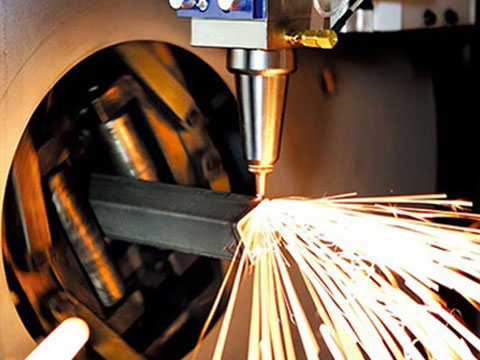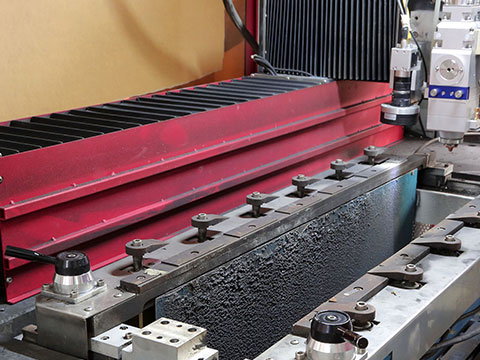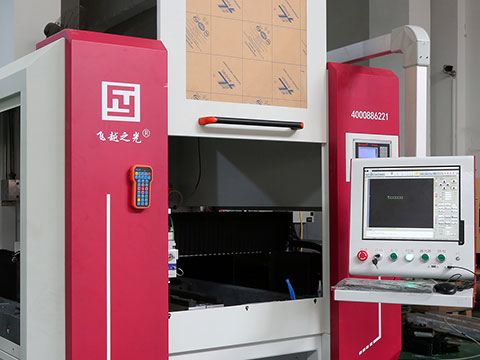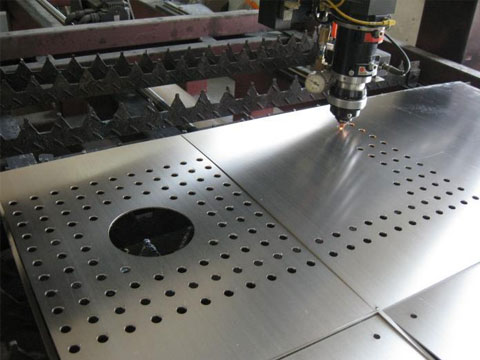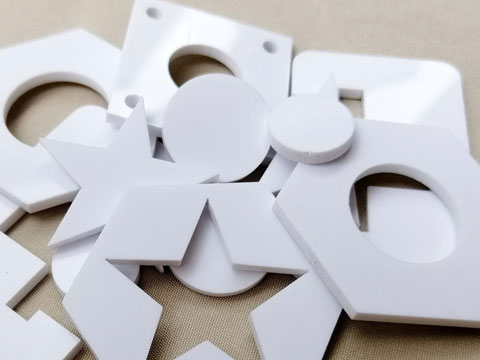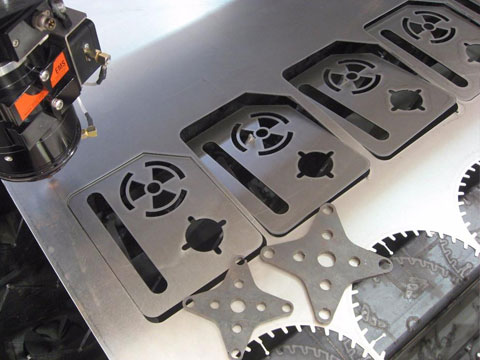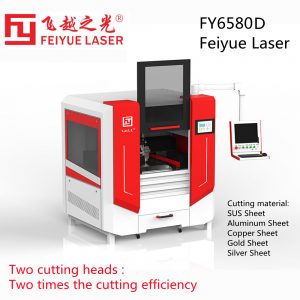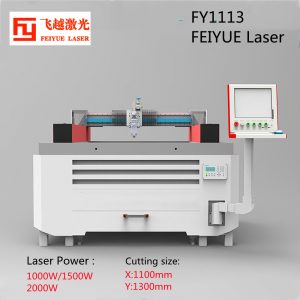What Is Laser Cutter?
The laser cutter is to focus the laser light emitted from the laser into a high-power density laser beam through the optical path system. The laser beam irradiates the surface of the workpiece to make the workpiece reach the melting point or boiling point, and the high-pressure gas coaxial with the beam blows away the molten or vaporized metal.
As the relative position of the beam and the workpiece moves, the material will eventually form a slit, so as to achieve the purpose of cutting.
Laser cutting is to replace the traditional mechanical knife with an invisible beam. It has the characteristics of high precision, fast cutting, not limited to the cutting pattern, automatic typesetting, saving material, smooth cutting, and low processing cost. It will gradually improve or replace it. Traditional metal cutting process equipment. The mechanical part of the laser cutter head has no contact with the workpiece, and will not scratch the surface of the workpiece during work; the laser cutting speed is fast, the incision is smooth and flat, and generally does not require subsequent processing; the cutting heat affected zone is small, the plate deformation is small, and the slit is narrow ( 0.1mm~0.3mm); the incision has no mechanical stress, no shearing burr; high processing accuracy, good repeatability, no damage to the surface of the material; CNC programming, can process any plan, can cut the entire board with a large format, without Opening the mold saves time and economy.
Compared with traditional oxyacetylene, plasma and other cutting processes, laser cutting speed is fast, the slit is narrow, the heat-affected zone is small, the edge of the slit is perpendicular, and the cutting edge is smooth. At the same time, there are many types of materials that can be laser cut, including carbon steel. , Stainless steel, alloy steel, wood, plastic, rubber, cloth, quartz, ceramics, glass, composite materials, etc. With the rapid development of the market economy and the rapid development of science and technology, laser cutting technology has been widely used in automobiles, machinery, electricity, hardware, and electrical appliances. In recent years, laser cutting technology is developing at an unprecedented speed, with an annual growth rate of 15% to 20%. Since 1985, China has grown at an annual rate of nearly 25%. At present, the overall level of laser cutting technology in China still has a big gap compared with advanced countries. Therefore, laser cutting technology in the Chinese market has broad development prospects and huge application space.
During the cutting process of the laser cutting machine, the beam is focused by the lens of the cutting head into a small focal point, so that the focal point can reach a high power density, and the cutting head is fixed on the z-axis. At this time, the heat input by the beam far exceeds the part of the heat reflected, conducted or diffused by the material, and the material is quickly heated to the melting and vaporization temperature. At the same time, a high-speed airflow will melt from the coaxial or non-coaxial side. And the vaporized material is blown out to form holes for cutting the material. With the relative movement of the focus and the material, the hole forms a continuous slit with a very narrow width to complete the cutting of the material.
At present, the outer optical path part of the laser cutting machine mainly adopts the flying optical path system. The light beam emitted from the laser generator reaches the focusing lens on the cutting head through the reflecting mirrors 1, 2, and 3, and forms a light spot on the surface of the material to be processed after focusing. The reflecting lens 1 is fixed on the fuselage without moving; the reflecting mirror 2 on the beam moves in the x direction with the movement of the beam; the reflecting lens 3 on the z axis moves in the y direction with the movement of the z axis. It is not difficult to see from the figure that in the cutting process, as the beam moves in the x direction and the z-axis part moves in the y direction, the length of the light path changes all the time.
At present, due to manufacturing cost and other reasons, the laser beams emitted by civilian laser generators have a certain divergence angle and are “conical”. When the height of the “cone” changes (equivalent to a change in the optical path length of the laser cutting machine), the cross-sectional area of the beam on the surface of the focusing lens also changes. In addition, light also has the properties of waves. Therefore, diffraction phenomenon will inevitably occur. Diffraction will cause the beam to expand laterally during propagation. This phenomenon exists in all optical systems and can determine the performance of these systems. Limit value. Due to the “cone” of the Gaussian beam and the diffraction effect of light waves, when the length of the optical path changes, the diameter of the beam acting on the lens surface changes momentarily, which will cause changes in the focus size and depth, but affect the focus position Very small. If the focus size and focus depth change during continuous processing, it will inevitably have a great impact on the processing. For example, it will cause inconsistent cutting slit widths, incomplete cutting or ablation of the board under the same cutting power.
Laser is a kind of light, like other natural light, it is produced by the transition of atoms (molecules or ions, etc.). However, it is different from ordinary light in that the laser only relies on spontaneous emission for a very short period of time, and the subsequent process is completely determined by the excitation radiation. Therefore, the laser has a very pure color, almost no divergent directionality, and extremely high luminous intensity. And high coherence.
Laser cutting is achieved by applying high power density energy generated by laser focusing. Under the control of the computer, the laser is discharged through pulses, thereby outputting a controlled repetitive high-frequency pulsed laser to form a beam with a certain frequency and a certain pulse width. The pulsed laser beam is guided and reflected by the optical path and focused by the focusing lens group. On the surface of the processed object, a small, high-energy-density light spot is formed. The focal spot is located near the surface to be processed, and the processed material is melted or vaporized at an instant high temperature. Each high-energy laser pulse instantly sputters a small hole on the surface of the object. Under computer control, the laser processing head and the processed material perform continuous relative movement according to the pre-drawn graphics, so that the object will be processed into The shape you want.
The process parameters (cutting speed, laser power, gas pressure, etc.) and movement trajectory during slitting are controlled by the numerical control system, and the slag at the slit is blown away by a certain pressure of auxiliary gas.
1. Vaporized cutting.
In the laser gasification cutting process, the speed of the material surface temperature rising to the boiling point temperature is so fast that it is enough to avoid melting caused by heat conduction, so part of the material vaporizes into steam and disappears, and part of the material is sprayed from the bottom of the slit by auxiliary gas The flow blows away. In this case, very high laser power is required.
In order to prevent material vapor from condensing on the slit wall, the thickness of the material must not greatly exceed the diameter of the laser beam. This process is therefore only suitable for applications where the removal of molten material must be avoided. This processing is actually only used in areas where iron-based alloys are very small.
This process cannot be used for materials such as wood and certain ceramics that are not in a molten state and therefore are unlikely to allow the material vapor to recondense. In addition, these materials usually require thicker cuts. In laser gasification cutting, the optimal beam focus depends on the material thickness and beam quality. The laser power and the heat of vaporization have only a certain influence on the optimal focus position. In the case of a certain thickness of the sheet, the maximum cutting speed is inversely proportional to the vaporization temperature of the material. The required laser power density is greater than 108W/cm2 and depends on the material, cutting depth and beam focus position. In the case of a certain sheet thickness, assuming sufficient laser power, the maximum cutting speed is limited by the gas jet speed.
2. Melting and cutting.
In laser melting and cutting, the workpiece is partially melted and the molten material is sprayed out with the help of airflow. Because the transfer of the material only occurs in its liquid state, the process is called laser melting and cutting.
The laser beam is matched with a high-purity inert cutting gas to drive the melted material away from the kerf, and the gas itself does not participate in the cutting. Laser melting cutting can get a higher cutting speed than gasification cutting. The energy required for gasification is usually higher than the energy required to melt the material. In laser melting and cutting, the laser beam is only partially absorbed. The maximum cutting speed increases with the increase of the laser power, and decreases almost inversely with the increase of the thickness of the sheet and the increase of the melting temperature of the material. In the case of a certain laser power, the limiting factor is the air pressure at the slit and the thermal conductivity of the material. Laser melting and cutting can obtain oxidation-free incisions for iron materials and titanium metals. The laser power density that produces melting but not gasification is between 104 W/cm2 and 105 W/cm2 for steel materials.
3. Oxidation melting cutting (laser flame cutting).
Melting cutting generally uses inert gas. If it is replaced by oxygen or other active gases, the material is ignited under the irradiation of the laser beam, and a fierce chemical reaction occurs with oxygen to generate another heat source to further heat the material, which is called oxidative melting cutting .
Due to this effect, for structural steel of the same thickness, the cutting rate that can be obtained by this method is higher than that of melting cutting. On the other hand, this method may have worse cut quality compared to fusion cutting. In fact, it will produce wider kerf, obvious roughness, increased heat-affected zone and worse edge quality. Laser flame cutting is not good when processing precision models and sharp corners (there is a danger of burning off the sharp corners). A pulsed laser can be used to limit the thermal influence, and the power of the laser determines the cutting speed. In the case of a certain laser power, the limiting factor is the supply of oxygen and the thermal conductivity of the material.
4. Control fracture cutting.
For brittle materials that are easily damaged by heat, high-speed and controllable cutting is performed by laser beam heating, which is called controlled fracture cutting. The main content of this cutting process is: the laser beam heats a small area of the brittle material, causing a large thermal gradient and severe mechanical deformation in this area, leading to the formation of cracks in the material. As long as a uniform heating gradient is maintained, the laser beam can guide cracks in any desired direction.
There are two types of laser cutting technology: One is pulsed laser which is suitable for metal materials. The second is that continuous laser is suitable for non-metallic materials, and the latter is an important application field of laser cutting technology.
Several key technologies of laser cutting machine are integrated technology of light, machine and electricity. In the laser cutting machine, the parameters of the laser beam, the performance and accuracy of the machine and the numerical control system all directly affect the efficiency and quality of the laser cutting. Especially for parts with high cutting accuracy or large thickness, the following key technologies must be mastered and solved:
Focus position control technology
One of the advantages of laser cutting is the high energy density of the beam, generally 10W/cm2. Since the energy density is inversely proportional to the area, the focal spot diameter is as small as possible to produce a narrow slit; at the same time, the focal spot diameter is also proportional to the focal depth of the lens. The smaller the focal depth of the focusing lens, the smaller the focal spot diameter. However, there are spatters in cutting, and the lens is too close to the workpiece to damage the lens. Therefore, the focal length of 5″~7.5″ (127~190mm) is widely used in general high-power CO2 laser cutting machine industrial applications. The actual focal spot diameter is 0.1~0.4 mm. For high-quality cutting, the effective focal depth is also related to the lens diameter and the material to be cut. For example, when cutting carbon steel with a 5″ lens, the focal depth is within +2% of the focal length, which is about 5mm. Therefore, control The position of the focus relative to the surface of the material to be cut is very important. Taking into account factors such as cutting quality and cutting speed, in principle, 6mm metal materials, the focus is on the surface; 6mm carbon steel, the focus is on the surface; 6mm stainless steel, the focus Below the surface. The specific size is determined by experiment.
There are three easy ways to determine the focal position in industrial production:
- Printing method: The cutting head is moved from top to bottom, and the laser beam is printed on the plastic plate, and the spot with the smallest printing diameter is the focus.
- Inclined plate method: Use a plastic plate placed obliquely at an angle to the vertical axis to pull it horizontally to find the smallest point of the laser beam as the focus.
- Blue spark method: remove the nozzle, blow air, hit the pulse laser on the stainless steel plate, and make the cutting head move from top to bottom until the largest blue spark is the focus.
For the cutting machine of the flying light path, due to the beam divergence angle, the length of the optical path is different between the proximal and distal ends of the cutting, and the beam size before focusing is different. The larger the diameter of the incident beam, the smaller the diameter of the focal spot. In order to reduce the change of the focal spot size caused by the change of the beam size before focusing, the manufacturers of laser cutting systems at home and abroad provide some special devices for users to choose:
- Parallel light pipe. This is a commonly used method, that is, a collimator is added to the output end of the CO2 laser for beam expansion. After the beam expands, the beam diameter becomes larger and the divergence angle becomes smaller, so that the proximal and distal ends of the cutting work range The beam size before focusing is nearly the same.
- Add an independent lower axis of the moving lens to the cutting head, which is two independent parts from the Z axis that controls the distance from the nozzle to the surface of the material (stand off). When the machine tool table moves or the optical axis moves, the beam moves from the proximal end to the distal F axis at the same time, so that the beam spot diameter remains the same in the entire processing area after the beam is focused. As shown in Figure 2.
- Control the water pressure of the focusing lens (usually a metal reflective focusing system). If the beam size before focusing becomes smaller and the focal spot diameter becomes larger, the water pressure is automatically controlled to change the focus curvature to make the focal spot diameter smaller.
- Add x and y direction compensation optical path system on the flying optical path cutting machine. That is, when the optical path at the distal end of the cutting is increased, the compensation optical path is shortened; on the contrary, when the optical path at the proximal end of the cutting is reduced, the compensation optical path is increased to keep the optical path length consistent.
The Main Parameters
- X, Y working range: 1300mm*2500mm
- Cutting focus lens: F=80mm
- Maximum laser output power: 500W
- Adjust the follow-up frequency: $300Hz
- Power pulse width: 0.5ms-2ms
- Laser: dual-lamp gold-plated condenser cavity
- Cutting interface card: CNC 3000 control card
- Cutting software: adapt to PLT, DXF and other formats
- Cooling power: 4W
- Repeated positioning accuracy: ±0.03/300mm
- Idle speed: 0-20000mm/min
- Cutting speed: 0-15000mm/min
Cutting Quality
Cutting accuracy is the first element to judge the quality of a CNC laser cutting machine. Four factors affecting the cutting accuracy of CNC laser cutting machines:
- The size of the laser condensate of the laser generator. If the light spot is very small after gathering, the cutting accuracy is very high, and the gap after cutting is also very small. It shows that the precision of the laser cutting machine is very high, and the quality is very high. But the light beam emitted by the laser is cone-shaped, so the slit cut out is also cone-shaped. Under this condition, the greater the thickness of the workpiece, the lower the accuracy, so the larger the slit.
- The accuracy of the workbench. If the accuracy of the table is very high, the accuracy of the cutting will also be improved. Therefore, the accuracy of the worktable is also a very important factor to measure the accuracy of the laser generator.
- The laser beam is condensed into a cone. When cutting, the laser beam is tapered downwards. At this time, if the thickness of the cut workpiece is very large, the cutting accuracy will be reduced, and the cut gap will be very large.
- Different cutting materials will also affect the accuracy of the laser cutting machine. Under the same circumstances, the precision of cutting stainless steel and aluminum will be very different, the precision of stainless steel cutting will be higher, and the cut surface will be smoother.
Generally speaking, the quality of laser cutting can be measured by the following 6 standards.
- Cutting surface roughness Rz
- Cutting slag size
- Cutting edge perpendicularity and slope u
- Cutting edge fillet size r
- Drag after stripes n
- Flatness F
Cutting Perforation
Cutting perforation technology: Any kind of thermal cutting technology, except for a few cases, which can start from the edge of the board, generally a small hole must be drilled in the board. Earlier on the laser stamping compound machine, a punch was used to punch out a hole, and then a laser was used to start cutting from the small hole. There are two basic methods of perforating for laser cutting machines without punching devices:
- Blast drilling: (Blast drilling), the material is irradiated by a continuous laser to form a pit in the center, and then the molten material is quickly removed by the oxygen stream coaxial with the laser beam to form a hole. Generally, the size of the hole is related to the plate thickness. The average diameter of the blasting hole is half of the plate thickness. Therefore, the blasting hole of the thicker plate is larger and not round, and it is not suitable for use on the parts with higher requirements (such as oil screen seam pipes). ), can only be used on scrap. In addition, since the oxygen pressure used for perforation is the same as that used for cutting, the splash is larger.
- Pulse drilling: (Pulse drilling) uses a high peak power pulse laser to melt or vaporize a small amount of material. Air or nitrogen is often used as an auxiliary gas to reduce the expansion of the hole due to exothermic oxidation. The gas pressure is higher than the oxygen pressure during cutting. small. Each pulse laser only produces small particle jets, which gradually penetrate deeper, so it takes a few seconds for the thick plate to perforate. Once the perforation is completed, immediately change the auxiliary gas to oxygen for cutting. In this way, the diameter of the perforation is smaller, and the perforation quality is better than that of blasting perforation. For this reason, the laser used should not only have a higher output power; more importantly, the time and space characteristics of the time beam, so the general cross-flow CO2 laser cannot meet the requirements of laser cutting.
In addition, pulse perforation requires a more reliable gas path control system to realize the switching of gas types, gas pressure and perforation time control. In the case of pulse perforation, in order to obtain a high-quality cut, the transition technology from pulse perforation when the workpiece is stationary to continuous cutting of the workpiece at constant velocity should be paid attention to. Theoretically speaking, it is usually possible to change the cutting conditions of the acceleration section: such as focal length, nozzle position, gas pressure, etc., but in fact, it is unlikely that the above conditions will be changed due to too short time. In industrial production, the main method of changing the average power of the laser is more realistic.
There are three specific methods:
- Changing the pulse width;
- Changing the pulse frequency;
- Changing the pulse width and frequency at the same time. The actual results show that third case has the best effect.
Nozzle Design
Nozzle design and airflow control technology: When laser cutting steel, oxygen and the focused laser beam are shot through the nozzle to the material to be cut, thus forming an airflow beam. The basic requirement of the air flow is that the air flow into the incision should be large and the speed should be high, so that there is enough oxidation to make the incision material fully carry out the exothermic reaction; at the same time, there is enough momentum to spray the molten material out. Therefore, in addition to the quality of the beam and its control directly affecting the cutting quality, the design of the nozzle and the control of the airflow (such as the nozzle pressure, the position of the workpiece in the airflow, etc.) are also very important factors.
The nozzle used for laser cutting adopts a simple structure, that is, a tapered hole with a small round hole at the end. Usually design with experiment and error method. Since the nozzle is generally made of red copper, the volume is small, and it is a vulnerable part that needs to be replaced frequently, so fluid mechanics calculation and analysis are not performed. When in use, a certain pressure Pn (gauge pressure is Pg) gas is introduced from the side of the nozzle, which is called the nozzle pressure, which is sprayed from the nozzle outlet and reaches the surface of the workpiece after a certain distance. The pressure is called the cutting pressure Pc, and finally the gas expands to atmospheric pressure. Pa. Research work shows that with the increase of Pn, the air flow rate increases, and Pc also increases.
The following formula can be used to calculate:
- V=8.2d2(Pg+1)
- V-gas flow rate L/min
- d-Nozzle diameter mm
- Pg- nozzle pressure (gauge pressure) bar
There are different pressure thresholds for different gases. When the nozzle pressure exceeds this value, the gas flow is a normal oblique shock wave, and the gas flow velocity transitions from subsonic to supersonic. This threshold is related to two factors: Pn, Pa ratio and the degree of freedom of gas molecules (n): For example, oxygen and air have n=5, so the threshold Pn=1bar×(1.2)3.5=1.89bar. When the nozzle pressure is higher Pn/Pa=(1+1/n)1+n/2 (Pn; 4bar), the normal airflow shock wave seal becomes a positive shock wave, the cutting pressure Pc drops, the airflow speed decreases, and The formation of vortex on the surface of the workpiece weakens the effect of the air flow to remove the molten material and affects the cutting speed. Therefore, the nozzle with a tapered hole and a small round hole at the end is used, and the nozzle pressure of the oxygen is often below 3bar.
In order to further increase the speed of laser cutting, according to the principle of aerodynamics, without generating a positive shock wave under the premise of increasing the nozzle pressure, a zoom-type nozzle, namely Laval nozzle, can be designed and manufactured. For the convenience of manufacturing, the structure shown in Figure 4 can be used. The Laser Center of the University of Hannover in Germany used a 500W CO2 laser with a lens focal length of 2.5〃, and a small hole nozzle and a Laval nozzle were used for experiments, as shown in Figure 4. The test results are shown in Fig. 5: It respectively represents the function relationship between the surface roughness Rz and the cutting speed Vc of the NO2, NO4, and NO5 nozzles under different oxygen pressures. It can be seen from the figure that the cutting speed of the NO2 small hole nozzle can only reach 2.75m/min (the thickness of the carbon steel plate is 2mm) when the Pn is 400Kpa (or 4bar). The cutting speed of NO4 and NO5 Laval nozzles can reach 3.5m/min and 5.5m/min when Pn is 500Kpa to 600Kpa. It should be pointed out that the cutting pressure Pc is also a function of the distance between the workpiece and the nozzle. Because the oblique shock wave is reflected multiple times at the boundary of the airflow, the cutting pressure changes periodically.
The first high cutting pressure zone is next to the nozzle outlet, and the distance from the workpiece surface to the nozzle outlet is about 0.5~1.5mm. The cutting pressure Pc is large and stable, which is a commonly used process parameter for cutting handles in industrial production. The second high cutting pressure zone is about 3~3.5mm of the nozzle outlet, and the cutting pressure Pc is also larger, which can also achieve good results, and is beneficial to protect the lens and increase its service life. Other high cutting pressure areas on the curve cannot be used because they are too far away from the nozzle outlet and difficult to match the focused beam.
The laser cutting machine system generally consists of a laser generator, an (external) beam transmission component, a workbench (machine tool), a microcomputer numerical control cabinet, a cooler, and a computer (hardware and software).
- The main machine part: the machine part of the laser cutting machine, the mechanical part that realizes the movement of the X, Y, and Z axes, including the cutting work platform. It is used to place the workpiece to be cut and can move it correctly and accurately according to the control program, usually driven by a servo motor.
- Laser generator: a device that generates a laser light source. For the purpose of laser cutting, except for a few occasions where YAG solid-state lasers are used, most of them use CO2 gas lasers with higher electrical-optical conversion efficiency and higher output power. Because laser cutting requires high beam quality, not all lasers can be used for cutting. The Gaussian mode is suitable for less than 1500W, low-order mode carbon dioxide lasers 100W-3000W, and multimode above 3000W.
- Outer optical path: Refractive reflector, used to guide the laser in the required direction. In order to prevent the beam path from malfunctioning, all mirrors must be protected by a protective cover, and a clean positive pressure protective gas should be introduced to protect the lens from contamination. A set of lenses with good performance will focus a beam with no divergence angle into an infinitely small spot. Generally, a lens with a focal length of 5.0 inches is used. The 7.5 inch lens is only used for thick materials> 12mm.
- Numerical control system: Control the machine tool to realize the movement of X, Y, Z axis, and also control the output power of the laser.
- Regulated power supply: connected between the laser, CNC machine tool and the power supply system. Mainly play a role in preventing interference from external power grids.
- Cutting head: It mainly includes parts such as cavity, focusing lens holder, focusing lens, capacitive sensor and auxiliary gas nozzle. The cutting head driving device is used to drive the cutting head to move along the Z axis according to the program, and is composed of a servo motor and a screw or gear and other transmission parts.
- Operating table: used to control the working process of the entire cutting device.
- Water chiller: used to cool the laser generator. A laser is a device that converts electrical energy into light energy. For example, the conversion rate of a CO2 gas laser is generally 20%, and the remaining energy is converted into heat. The cooling water takes away the excess heat to keep the laser generator working normally. The chiller also cools the external light path reflector and focusing mirror of the machine tool to ensure stable beam transmission quality and effectively prevent the lens from being deformed or broken due to excessive temperature.
- Gas cylinders: Including the working medium gas cylinders and auxiliary gas cylinders of the laser cutting machine, which are used to supplement the industrial gas for laser oscillation and supply auxiliary gas for the cutting head.
- Air compressor, air storage tank: provide and store compressed air.
- Air cooling dryer, filter: used to supply clean and dry air to the laser generator and beam path to keep the path and reflector working normally.
- Ventilation dust collector: extract the smoke and dust generated during processing, and carry out filtering treatment, so that the exhaust gas discharge meets the environmental protection standards.
- Slag discharge machine: remove the leftovers and scraps generated during processing.
Laser
CO2 gas laser
Since laser technology was introduced to cut thin metal sheets, CO2 lasers have dominated the market. The CO2 laser light source requires a lot of energy to excite nitrogen molecules to collide with CO2 molecules (laser gas), prompting them to emit photons, and finally forming a laser beam that can cut through the metal. The molecular activity in the cavity releases light as well as heat, which requires a cooling system to cool the laser gas. This means that more energy is consumed during the cooling process, further reducing energy efficiency.
Fiber-optic laser
The machine using fiber laser occupies a small area, the laser light source and cooling system are also smaller; there is no laser gas pipeline, and no need to adjust the lens. A fiber laser light source with a power of 2kw or 3kw only needs 50% of the energy consumption of a 4kw or 6kw CO2 laser light source to achieve the same performance, with faster speed, lower energy consumption and less impact on the environment.
The fiber laser uses solid-state diodes to pump the molecules in the double-clad ytterbium-doped fiber. The stimulated emission of light passes through the fiber core multiple times, and then the laser is output through the transmission fiber to the focusing head for cutting. Since all intermolecular collisions occur in the fiber, no laser gas is needed, so the energy required is greatly reduced-about one-third of the CO2 laser. As the less heat is generated, the volume of the cooler can be reduced accordingly. In short, while achieving the same performance, the overall energy consumption of fiber lasers is 70% lower than that of CO2 lasers.
The application of metal laser cutting machine is very wide, covering many industries, and it is one of the necessary equipment for many companies, including advertising sign production (these are mainly stainless steel LOGO and logo cutting), sheet metal processing (sheet metal cutting) Metal processing basically includes all metal materials. These are generally bending, grinding, etc., and cutting is the most important process), chassis and cabinet production (in this regard, carbon steel or stainless steel is generally useful, but also mainly folding Bending and cutting 2 cutting processes), springs (belonging to the finishing process), subway parts, as well as the production of elevator shells, mechanical equipment shells, and kitchen utensils (mostly stainless steel), which surpass lasers The laser cutting machine setting of the company is also involved in the production of the seven-seven-shen-eight spacecraft, which actually involves various aspects.
Widely used in sheet metal processing, advertising sign production, high and low voltage electrical cabinet production, mechanical parts, kitchenware, automobiles, machinery, metal crafts, saw blades, electrical parts, glasses industry, springs, circuit boards, electric kettles, medical micro Electronics, hardware, knife measuring tools and other industries.
The application of laser processing technology in the advertising industry mainly includes two working methods: laser cutting and laser engraving.
- Laser engraving: It is mainly carried out on the surface of the object, and it is divided into two types: bitmap engraving and vector engraving:
- Bitmap engraving: We first carry out the screen processing of the graphics we need to engrave in PHOTOSHOP and convert them into monochrome BMP format, and then open the graphics file in the dedicated laser engraving and cutting software. According to the material we are processing, we can set the appropriate parameters, and then click to run, the laser engraving machine will engrave according to the dot matrix effect produced by the graphic file.
- Vector engraving: Use vector software such as Coreldraw, AutoCad, Illustrator and other typesetting design, and export the graphics to PLT, DXF, AI format, marking machine, and then use the special laser cutting and engraving software to open the graphic file and send it to laser engraving Processing in the machine.In the advertising industry, it is mainly suitable for the processing of wood, two-color boards, plexiglass, colored paper and other materials.
- Laser cutting: We can understand it as the separation of edges. For such processing purposes, we should first make the graphics in the form of vector lines in CORELDRAW, AUTOCAD, pneumatic marking machine, and then save the corresponding PLT, DXF format, use the laser cutting machine operating software to open the file, according to our The processed material can be run after setting the parameters such as energy and speed. The laser cutting machine will automatically cut according to the flight path generated by the software after receiving instructions from the computer. For example, the existing laser cutting machine can draw a template according to the computer, and then directly input it into the computer to automatically cut the graphics. Existing laser cutting machines generally have their own hard disk, which can input massive data sources.
In order to reduce the manufacturing cycle of large stamping dies, CNC nibbling and electrical machining technologies have been developed. Various cutting methods have their shortcomings and have a certain scope of application in industrial production. The development and application of laser cutting machines are undoubtedly a major improvement and innovation breakthrough in modern industrial production.
|
Process Name
|
Cut(mm)
|
Be Out Of Shape
|
Precision
|
Graphic Changes
|
Speed
|
Cost
|
|
Laser Cutting
|
0.1-0.3
|
Very Small
|
High0.2mm
|
Very Easy
|
Slow
|
Higher
|
|
Plasma Cutting
|
Smaller
|
Larger
|
High1mm
|
Very Easy
|
High Speed
|
Lower
|
|
Water Cutting
|
Larger
|
Small
|
High
|
Easy
|
High Speed
|
Higher
|
|
Die Cutting
|
Smaller
|
Larger
|
Low
|
Difficult
|
High Speed
|
Lower
|
|
Saw Cutting
|
Larger
|
Smaller
|
Low
|
Difficult
|
Very Slow
|
Lower
|
|
Wire Cutting
|
Smaller
|
Very Small
|
High
|
Easy
|
Very Slow
|
Higher
|
|
Gas Cutting
|
Very Big
|
Very Large
|
Low
|
Easier
|
Slow
|
Lower
|
|
EDM Cutting
|
Very Small
|
Very Small
|
High
|
Easy
|
Very Slow
|
Tallest Cost
|
With the development of laser cutting technology, laser cutting is used in more and more fields, and more and more materials are applicable. But different materials have different characteristics, so the matters needing attention when using laser cutting are also different.
- Structural Steel:Better results will be obtained when this material is cut with oxygen. When oxygen is used as the processing gas, the cutting edge will be slightly oxidized. For plates with a thickness of 4mm, nitrogen can be used as a processing gas for high-pressure cutting. In this case, the cutting edge will not be oxidized. For plates with a thickness of more than 10mm, using a special pole plate for the laser and oiling the surface of the workpiece during processing can get better results.
- stainless Steel:Cutting stainless steel requires: oxygen is used, when the edge oxidation is not a problem; nitrogen is used to obtain an oxidation-free and burr-free edge, and no further treatment is required. Coating the oil film on the surface of the plate will get a better perforation effect without reducing the processing quality.
- Aluminum:Despite its high reflectivity and thermal conductivity, aluminum with a thickness of 6mm or less can be cut, depending on the alloy type and laser capabilities. When cutting with oxygen, the cutting surface is rough and hard. When using nitrogen, the cutting surface is smooth. Pure aluminum is very difficult to cut because of its high purity. Aluminum can only be cut when a “reflection absorption” device is installed on the system. Otherwise, the reflection will destroy the optical components.
- Titanium:The titanium sheet is cut with argon and nitrogen as the processing gas. Other parameters can refer to nickel-chromium steel.
- Copper And Brass:Both materials have high reflectivity and very good thermal conductivity. Brass with a thickness of 1mm or less can be cut with nitrogen; copper with a thickness of 2mm or less can be cut, and the processing gas must be oxygen. Copper and brass can only be cut when a “reflection absorption” device is installed on the system. Otherwise, the reflection will destroy the optical components.
- Synthetic Material:When cutting synthetic materials, keep in mind the dangers of cutting and the dangerous substances that may be emitted. Synthetic materials that can be processed are: thermoplastics, thermosetting materials and synthetic rubber.
- Organic Matter :There is a fire hazard in all organic cutting (nitrogen is used as the processing gas, and compressed air can also be used as the processing gas). Wood, leather, cardboard and paper can be laser cut, and the cut edges will be burnt (brown).
First, you must figure out the scope of your company’s production, processing materials and cutting thickness, etc., so as to determine the model, format and quantity of the equipment to be purchased, so as to make a simple pavement for the later procurement work. The application fields of laser cutting machines involve mobile phones, computers, sheet metal processing, metal processing, electronics, printing, packaging, leather, clothing, industrial fabrics, advertising, crafts, furniture, decoration, medical equipment and many other industries. The mainstream on the market is 3015 and 2513, that is, 3 meters times 1.5 meters and 2.5 meters times 1.3, but the format is not a problem. Generally, companies will have many formats for customers to choose from, which can be customized.
Professionals conduct on-site simulation solutions or provide solutions, and at the same time, they can also take their own materials to the factory for proofing.
- The cutting seam is fine: the cutting seam of laser cutting is generally 0.10mm-0.20mm;
- The cutting surface is smooth: whether the laser cutting surface has burrs or not; generally speaking, YAG laser cutting machines have some burrs, which are mainly determined by the cutting thickness and the gas used. Generally, there is no burr below 3mm. Nitrogen gas has the best effect, oxygen effect is second, and air effect is the worst. The fiber laser cutting machine has the least or no burrs, the cutting surface is very smooth, and the speed is very fast.
- Look at the deformation of the material: the deformation of the material is very small
- The size of power: For example, most factories cut metal sheets below 6mm, so there is no need to buy a high-power laser cutting machine. A 500W fiber laser cutting machine can meet the production needs. If the production volume is large, worry about the 500W efficiency. Inferior to high-power laser cutting machines, the best choice is to buy two or more small and medium-power laser cutting machines, which will help manufacturers in terms of cost control and efficiency improvement.
- The core parts of laser cutting: Are lasers and laser heads imported or domestically produced. Imported lasers generally use more IPGs, and domestic ones generally use Raycus. At the same time, other accessories for laser cutting are also required. Pay attention to whether the motor is imported servo motor, guide rail, bed, etc., because they affect the cutting accuracy of the machine to a certain extent. One thing that needs special attention is the cooling system of the laser cutting machine-the cooling cabinet. Many companies directly use household air conditioners for cooling. In fact, everyone knows that the effect is very bad. The best way is to use industrial air conditioners, which are dedicated for special machines. , In order to achieve the best results.
Any piece of equipment will be damaged to varying degrees during use, so in terms of repairing after damage, whether the repair is timely and the cost of the repair has become a problem that needs to be considered. Therefore, the purchase is to understand the company’s after-sales service issues through multiple channels, such as whether the maintenance fee is reasonable, and so on.
The Revolutionary Technology That Set Feiyue Laser Cutter Apart
We don't strive to be the largest seller of laser cutting or laser engraving machines. Our goals are simple: to sell the best laser machine, at the lowest cost, and provide industry-leading customer service.
See What Clients Are Saying
We are very proud of the service we provide and stand by every machine we carry.
Read our testimonials from our happy customers.
We’ve been using it for about 2 months for metal jewelry. With it’s built-in software, safety features, and great support service, it’s truly the best metal laser cutter for the crafter or small business. The unit was shipped very promptly and was well packaged.
As the saying goes: “You get what you paid for”. The metal laser cutter arrived well packed and showed no shipping damages. The laser cutter works great. I use it to make jewelry and cut sheet metals. Can get very detailed as long as you make sure the laser cut file is right.
The fiber laser machine has performed and delivery was sooner better than expected. I have been cutting tags and signs, and it has done a very good job. Thanks to your help videos from the nice supplier. It’s a good business machine.
Not as big as I expected, but more portable.The fiber laser machine has performed and delivery was sooner better than expected. I have been cutting tags and signs, and it has done a very good job. Thanks to your help videos from the nice supplier. It’s a good business machine.
Looking For Powerful Laser Cutting Machine?
Choose Feiyue,Choose Core Advantages
More Than 40 Independent Research Development Patents

